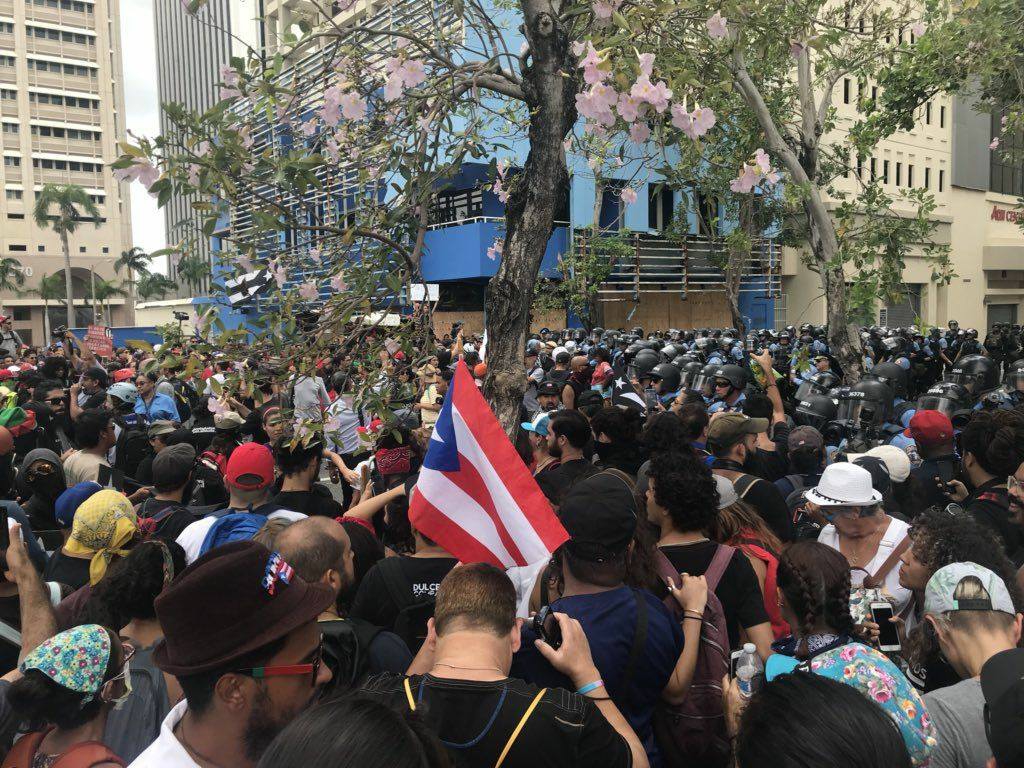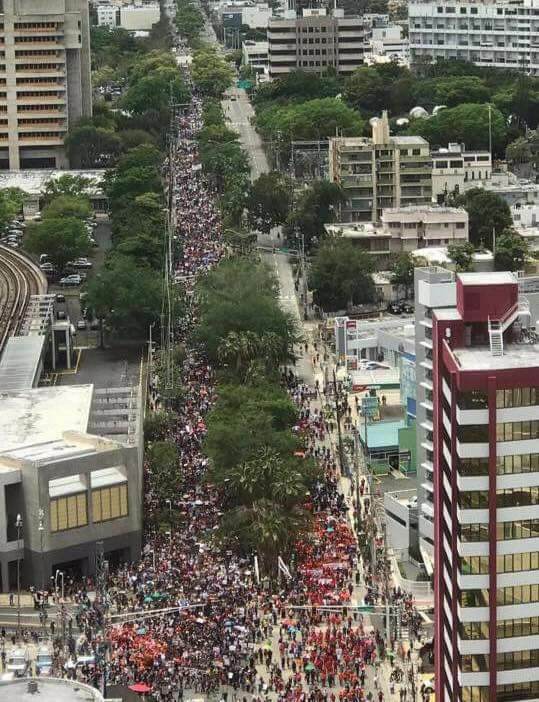
On International Workers Day many thousands of Puerto Ricans continued the island’s long tradition of struggle by going on strike and taking the streets to protest the austerity measures proposed by Governor Ricardo Rosselló and ‘La Junta.’ As the march approached La Junta offices, it was brutally attacked by police. But even a police riot could not detract from the success of the strike and protest nor the strong message the actions sent to government: working people in Puerto Rico will fight back.

Participating in the May 1 national strike and rally were union workers from both public and private sectors, retirees, and many teachers, families and students. It was the largest working class response to date to the pension cuts, rising university tuition, mass school closures, privatization of schools and the sluggish recovery efforts after Hurricane Maria struck eight months ago.
Unprovoked attack by police
In the neighborhood of Hato Rey, San Juan’s financial district, the people came up against what Martinez Padilla, President of the Federación de Maestros de Puerto Rico (FMPR), one of the leading organizers of the strike, has called “a police provocation. The demonstrators, she said, “were cornered in order to spark moves to justify the attacks by the police.” The officers, heavily armed in protective gear, prevented protesters from marching forward and fired tear gas and rubber bullets at the crowd which included many children, teachers, journalists and legal observers.
“They sent over 1,000 police to intimidate the protest,” Martinez Padilla added. “People [were] hurt and in the hospital. It was brutal. They chased students to their homes, entered without warrants, and arrested them,” she continued.
Martinez Padilla continued, “The state violence enacted on the protesters was a way of attempting to silence the voices of indignation of the people who have been hurt the most by an economic crisis that has been exacerbated by the aftermath of Hurricane Maria.”
In an interview with El Vocero, Martinez Padilla declared the national strike a success, despite the brutality of the police officers. She stated that the strike and protest delivered a strong message to the government and the Secretary of Education Julia Keleher. She noted that 25 percent of educators were not at their job posts on May Day meaning that roughly 8,000 teachers were a part of the mass demonstrations. Additionally, she notes that the Department of Education reported that 93.8 percent of students were not in attendance, and called this an indisputable success for school communities.
Washington takes over Puerto Rican economy
The May Day national strike is a direct response to the neoliberal reforms that La Junta and Rosselló plan to implement in Puerto Rico. ‘La Junta’ is what the people of Puerto Rico call the Washington-appointed financial management board which has taken over the economy and is restructuring the island’s $72 billion debt on the backs of the people. Under attack is the minimum wage, pensions, healthcare, education, and welfare.
Hurricane Maria and its aftermath–the lack of electricity, the destruction of homes, and FEMA’s slow– response have only accelerated the restructuring plans.
Looking to New Orleans post-Katrina for inspiration, Rosselló unveiled plans in January to privatize the education sector by increasing charter and private schools. In March, a bill was passed to shut down 300 public schools, a quarter of those in Puerto Rico, and to cut pensions.
Tuition doubled at public university
Then there is the attack on public universities. Adria Bermudez a student, came to the May 1 demonstration to protest a recent vote by the financial oversight board to double tuition at Puerto Rico’s largest public university, making a higher educational unaffordable to many. Undergraduate cost per credit went from U.S. $57 to U.S. $115. The measures are aimed at the workers, and Bermudez told the Associated Press “at the the middle class and the lower middle class. The rich don’t suffer.”
Teachers are leading the way
Standing out among the crowds of protesters on May were groups in yellow shirts from the teachers union, the Federación de Maestros de Puerto Rico (FMPR). They were there with their families, other parents and students.
Puerto Rico has a long history of popular resistance, and some very militant trade unions. The FMPR is among them. Since 2008, this union has fought privatization of schools and school closures. Its members organize teachers and parents in both rural and urban areas, and empowers them to fightt biased testing, the linking of teacher ratings to student test scores, charter schools and school closures.
FMPR brought Puerto Rican teachers, parents and students into the streets in March to protest the attack on public education. They did it again along with thousands of others on May 1, and they don’t plan to stop. They are not alone. As the union’s president, Mercedes Martinez Padilla puts it, “This is the class struggle.”





